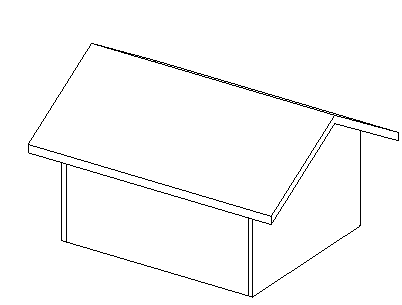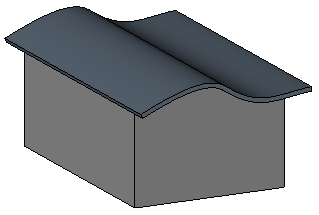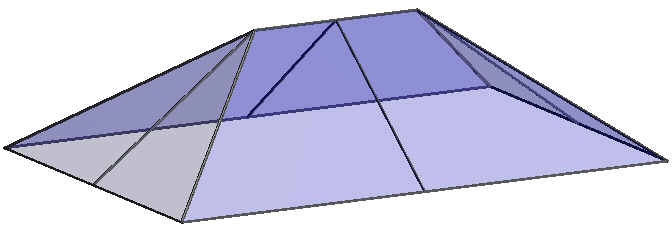Add a roof using one of the following methods:
Sketch a roof by footprint
- Display a floor plan view or a reflected ceiling plan view.
- Click Architecture tab
 Build panel
Build panel Roof drop-down
Roof drop-down
 (Roof by Footprint). Note: If you try to add a roof on the lowest level, a dialog prompts you to move it to a higher level. If you choose not to move the roof to a different level, Revit notifies you later if the roof is too low.
(Roof by Footprint). Note: If you try to add a roof on the lowest level, a dialog prompts you to move it to a higher level. If you choose not to move the roof to a different level, Revit notifies you later if the roof is too low. - On the Draw panel, select a sketch or pick tool.
To edit roof properties before sketching, use the Properties palette.
Tip: When using Pick Walls, you can specify the overhang before you sketch the roof. On the Options Bar, select Extend to wall core if you want the overhang to be measured from the core of the wall, and then specify a value for Overhang. - Sketch, or pick, a closed loop for the roof.
- Specify slope defining lines.
To change the slope definition of a line, select the line and, on the Properties palette, click Defines Roof Slope. You can then change the slope value.
When a roof line is set to slope defining, this symbol
 appears adjacent to it.
appears adjacent to it. 
- Click
 (Finish Edit Mode), and then open a 3D view.
(Finish Edit Mode), and then open a 3D view. 
Completed gable roof with overhang
Sketch a roof by extrusion
- Display an elevation, 3D, or section view.
- Click Architecture tab
 Build panel
Build panel Roof drop-down
Roof drop-down
 (Roof by Extrusion).
(Roof by Extrusion). - Specify the work plane.
- In the Roof Reference Level and Offset dialog, select a value for Level. The highest level in the project is selected by default.
- To raise or lower the roof from the reference level, specify a value for Offset.
Revit places a reference plane at the specified offset. Using the reference plane, you can control the position of the extruded roof in relation to a level.
- Sketch the profile of the roof as an open loop.

Roof profile sketched using spline tool
- Click
 (Finish Edit Mode), and then open a 3D view.
(Finish Edit Mode), and then open a 3D view. 
Completed extruded roof
Attach walls to the roof, if desired.
After you create a roof by extrusion, you can rehost the roof or edit the work plane of the roof.
Sketch sloped glazing
- Click Architecture tab
 Build panel
Build panel Roof drop-down
Roof drop-down
 (Roof by Footprint) or
(Roof by Footprint) or  (Roof by Extrusion). Note: If you try to create a roof on the lowest level, a dialog prompts you to move it to a different level, ensuring that the roof is higher than any walls joining to it. If you choose not to move the roof to a different level, Revit notifies you later if the roof is too low.
(Roof by Extrusion). Note: If you try to create a roof on the lowest level, a dialog prompts you to move it to a different level, ensuring that the roof is higher than any walls joining to it. If you choose not to move the roof to a different level, Revit notifies you later if the roof is too low. - Sketch the roof.
- If the roof is based on a footprint, specify roof boundary lines as slope-defining, or use the roof slope arrow to define the slope.
- Click
 (Finish Edit Mode).
(Finish Edit Mode). - Select the roof, and in the Type Selector, select Sloped Glazing.
You can place curtain grids on the curtain panels of the sloped glazing. Press Tab to switch between horizontal and vertical grids.

Sloped glazing with mullions and grid lines
Add a roof to another roof
- To cut off a roof in order to sketch another roof on top of it, select the roof in the drawing area.
- On the Properties palette, specify a Cutoff Level, and then specify a height for Cutoff Offset.
This property specifies the distance above or below the level at which the roof is cut off.
- Sketch the new roof on top of the existing roof.
Create a conical roof
- In the drawing area, select the arc line.
- On the Properties palette, specify a value for Number of Full Segments.
If you specify zero segments (the default), a conical roof is created.
If a roof includes a slope-defining arc line or circle, it creates a conical roof. If desired, you can divide the arc or circle into segments as follows.